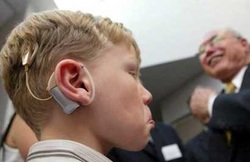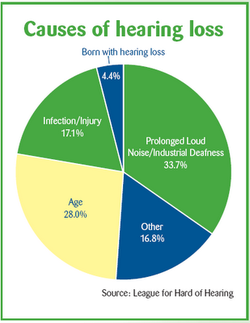Symptom finder- The causes of deafness

Symptom finder - The causes of deafness
What is deafness ? Deafness is defined as loss of hearing. Deafness is divided into sensorineural loss or conductive deafness.
The common causes of sensorineural deafness are congenital or acquired causes. The congenital causes are cytomegalovirus infection, toxoplasmosis and maternal rubella. The acquired causes of sensorineural deafness are head injuries or noise induced trauma, tumor such as brain tumor, acoustic neuroma, vestibular schwannoma and Paget disease, infection such as meningitis, herpes zoster and mumps, drugs such as aspirin, furosemide and aminoglycoside, Meniere’s disease and presbycusis or age related.
The common cause of conductive deafness are also congenital and acquired. The congenital causes of deafness ( conductive ) is atresia of meatus. The acquired causes are otosclerosis, trauma such as barotrauma, perforation of the tympanic membrane, infection such as glue ear/otitis media or otitis externa and obstruction such as foreign body or wax.
The history of patient presenting with complain of loss of hearing include focusing on duration, onset, pain, precipitating factors, associated factors and any drug history.
The duration of loss of hearing may associate with the introduction of ototoxic drugs. Childhood deafness is associated with infection such as cytomegalovirus, toxoplasmosis and meningitis or from maternal rubella infection.
The gradual onset of deafness is associated with age, tumor or otosclerosis . The sudden onset of deafness is commonly associated with the present of foreign bodies in the ear canal which later perforate the tympanic membrane and affect the ossicles. Trauma, Meniere’s disease and vascular incident may also cause sudden deafness.
Pain is associated with deafness in case of herpes zoster infection , otitis media or otitis externa. Besides that pain which us worst in nature /severe may occur due to barotrauma such as scuba diving or slap in the ear or direct trauma such as perforation of the tympanic membrane.
The predisposing factors for deafness may include prolonged exposure to loud noise or mumps ( complication) leads to sensorineural deafness and trauma.
Meniere’s disease is presented with deafness , tinnitus and vertigo as associated symptoms. Tinnitus that occur with deafness are associated with acoustic neuroma, otosclerosis, ototoxic drugs and exposure to loud noise.
Drug history is important to identify any intake of ototoxic drugs.
Examination should focus on examination of the ear and examination of hearing. Inspection of the ear may reveal the present of otitis externa or vesicles of herpes zoster. Otitis externa is confirmed with the present of erythematous, scaly skin and exudates. Compression of the tragus and movement of the pinna may cause/elicit the pain. This is follow late by otoscopic examination which may reveal any foreign bodies or ear wax which will occlude the external auditory canal. The tympanic membrane will be visualized in case of patent ear canal. The present of blood or tympanic teat may indicate tympani/
What is deafness ? Deafness is defined as loss of hearing. Deafness is divided into sensorineural loss or conductive deafness.
The common causes of sensorineural deafness are congenital or acquired causes. The congenital causes are cytomegalovirus infection, toxoplasmosis and maternal rubella. The acquired causes of sensorineural deafness are head injuries or noise induced trauma, tumor such as brain tumor, acoustic neuroma, vestibular schwannoma and Paget disease, infection such as meningitis, herpes zoster and mumps, drugs such as aspirin, furosemide and aminoglycoside, Meniere’s disease and presbycusis or age related.
The common cause of conductive deafness are also congenital and acquired. The congenital causes of deafness ( conductive ) is atresia of meatus. The acquired causes are otosclerosis, trauma such as barotrauma, perforation of the tympanic membrane, infection such as glue ear/otitis media or otitis externa and obstruction such as foreign body or wax.
The history of patient presenting with complain of loss of hearing include focusing on duration, onset, pain, precipitating factors, associated factors and any drug history.
The duration of loss of hearing may associate with the introduction of ototoxic drugs. Childhood deafness is associated with infection such as cytomegalovirus, toxoplasmosis and meningitis or from maternal rubella infection.
The gradual onset of deafness is associated with age, tumor or otosclerosis . The sudden onset of deafness is commonly associated with the present of foreign bodies in the ear canal which later perforate the tympanic membrane and affect the ossicles. Trauma, Meniere’s disease and vascular incident may also cause sudden deafness.
Pain is associated with deafness in case of herpes zoster infection , otitis media or otitis externa. Besides that pain which us worst in nature /severe may occur due to barotrauma such as scuba diving or slap in the ear or direct trauma such as perforation of the tympanic membrane.
The predisposing factors for deafness may include prolonged exposure to loud noise or mumps ( complication) leads to sensorineural deafness and trauma.
Meniere’s disease is presented with deafness , tinnitus and vertigo as associated symptoms. Tinnitus that occur with deafness are associated with acoustic neuroma, otosclerosis, ototoxic drugs and exposure to loud noise.
Drug history is important to identify any intake of ototoxic drugs.
Examination should focus on examination of the ear and examination of hearing. Inspection of the ear may reveal the present of otitis externa or vesicles of herpes zoster. Otitis externa is confirmed with the present of erythematous, scaly skin and exudates. Compression of the tragus and movement of the pinna may cause/elicit the pain. This is follow late by otoscopic examination which may reveal any foreign bodies or ear wax which will occlude the external auditory canal. The tympanic membrane will be visualized in case of patent ear canal. The present of blood or tympanic teat may indicate tympani/

traumatic perforation . Otitis media may present with frank perforation or erythematous tympani membrane.
Examination of hearing /assessment of hearing may include crude test, Rinne’s test and Weber’s test. Crude test may involve testing the hearing with voice of conversation, whispered voice or measuring the distance on how far can you heard the ticking of the watch. Rinne’s test is performed by comparing the feeling/hearing vibration between the ear ( air conduction) or mastoid ( bone conduction) using the 512 Hz of the tuning fork. Normally the air conduction better than the bone conduction . Weber’s test is performed while holding a base of the already struck tuning fork against the center part of the forehead. In normal individual , the sound is equally heard in both ears.
Sensorineural deafness is characterized by airway conduction which is better than bony conduction ( Rinne’s test ) and in Weber test the sound is heard in the good ear, Conductive deafness is characterized by bony conduction which is better than air conduction ( Rinne’s test) and in Weber test the sound is heard in the bad ear.
Generally the examination may focus on neurological examination. Acoustic neuroma may rarely present with unilateral facial paralysis. Brain tumor may present with motor/ sensory deficit while nystagmus is common with Meniere’s disease. Nasopharyngeal sepsis is one of the predisposing factor for infection go the middle ear that lead to deafness, so consider examination of the throat and the nose.
The investigations require to elicit the causes of deafness are swabs of discharge from the ear ( possible infection), pure tone audiometry which permits accurate measurement of the level of hearing with air or bony conduction. Hearing in babies can be assessed with electric response audiometry. Speech audiometry is useful to identify any impairment in speech discrimination. 50% - 80% of impairment in speech discrimination occur due to conductive deafness and 0 % - 50 % impairment of speech discrimination occur in sensorineural deafness. MRI is useful in detection of brain tumor or acoustic neuroma. Impedance tympanometry is useful to detect otitis media with effusion ( reduced compliance by increasing impedance).
Examination of hearing /assessment of hearing may include crude test, Rinne’s test and Weber’s test. Crude test may involve testing the hearing with voice of conversation, whispered voice or measuring the distance on how far can you heard the ticking of the watch. Rinne’s test is performed by comparing the feeling/hearing vibration between the ear ( air conduction) or mastoid ( bone conduction) using the 512 Hz of the tuning fork. Normally the air conduction better than the bone conduction . Weber’s test is performed while holding a base of the already struck tuning fork against the center part of the forehead. In normal individual , the sound is equally heard in both ears.
Sensorineural deafness is characterized by airway conduction which is better than bony conduction ( Rinne’s test ) and in Weber test the sound is heard in the good ear, Conductive deafness is characterized by bony conduction which is better than air conduction ( Rinne’s test) and in Weber test the sound is heard in the bad ear.
Generally the examination may focus on neurological examination. Acoustic neuroma may rarely present with unilateral facial paralysis. Brain tumor may present with motor/ sensory deficit while nystagmus is common with Meniere’s disease. Nasopharyngeal sepsis is one of the predisposing factor for infection go the middle ear that lead to deafness, so consider examination of the throat and the nose.
The investigations require to elicit the causes of deafness are swabs of discharge from the ear ( possible infection), pure tone audiometry which permits accurate measurement of the level of hearing with air or bony conduction. Hearing in babies can be assessed with electric response audiometry. Speech audiometry is useful to identify any impairment in speech discrimination. 50% - 80% of impairment in speech discrimination occur due to conductive deafness and 0 % - 50 % impairment of speech discrimination occur in sensorineural deafness. MRI is useful in detection of brain tumor or acoustic neuroma. Impedance tympanometry is useful to detect otitis media with effusion ( reduced compliance by increasing impedance).
